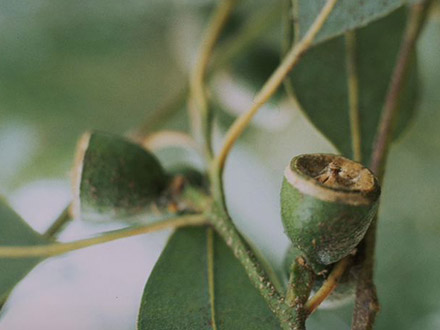Botanical name
Eucalyptus globulus Labill.
Family
Myrtaceae
Common name
Eucalyptus, Gum tree, Blue gum, Southern blue gum, Tasmanian blue gum, Stringybark (Australia)
Information about the plant
The eucalyptus tree is native to the subtropical rainforests of South Australia and Tasmania. Over 600 species of Eucalyptus constitute the majority of Australia's tree population, many of which are important sources of timber, some of which are also ornamental trees. The very fast-growing tree was cultivated in the tropics, subtropics, and other frost-free areas to drain swamps. Nowadays, the eucalyptus tree can also be found in North Africa, from California to Chile, and in the Mediterranean region. The name is derived from the Greek words 'eu' (= beautiful, good) and 'kalyptos' (= hidden), referring to the flower buds, which are covered by a tight lid before opening and are, therefore, "well hidden".
The trees can reach a height of up to 60 meters. They are characterized by their silver-gray, warty bark, and twisted trunk. The leaves of young trees are oval cordate, only the leathery-hard leaves of older trees have the typical sickle shape. The flower bud is enclosed in a decorative, silvery capsule, the lid of which opens when the flower blooms. The large white flowers are characterized by the long stamens.
Medicinally used parts of plants (herbal drug)
The dried leaves (eucalyptus leaves – Eucalypti folium) with their typical eucalyptus scent, which can be clearly perceived when rubbed, are used. The scent is caused by an essential oil that is found in large oil reservoirs in the leaf tissue. When light shines through the leaves, they appear dotted with glands.
The drug on the market is imported from Spain, Morocco, and Russia.
The essential oil (eucalyptus oil - Eucalypti aetheroleum) is obtained from the leaves and twigs of various eucalyptus species whose essential oil is rich in cineole. It is mainly imported from China.
Constituents of the herbal drug
Eucalyptus leaves contain essential oil ("eucalyptus oil") with its aromatic smell of 1,8-cineole (main component), as well as euglobals and macrocarpals.
Quality of the drug
The quality of the following drugs or drug preparations is specified in the European Pharmacopoeia (Ph. Eur.):
- Eucalyptus leaves (Eucalypti folium)
- Eucalyptus oil (Eucalypti aetheroleum
Medical applications
Recognised medical use
HMPC: The HMPC has classified eucalyptus leaves and eucalyptus oil as traditional herbal medicinal products (see "Traditional use").
Traditional use
Eucalyptus leaves have been classified by the HMPC as a traditional herbal medicinal product (Article 16a of Directive 2001/83/EC). Based on long-standing use, eucalyptus leaves can be used for coughs associated with colds.
Eucalyptus oil has been classified by the HMPC as a traditional herbal medicinal product (§ 39a AMG). Based on long-standing use, eucalyptus oil can be used for relief of cough associated with the common cold and symptoms of localised muscle pain.
ESCOP: Eucalyptus oil: Internally for the supportive treatment of chronic respiratory complaints including bronchitis and bronchial asthma; for the symptomatic treatment of catarrh of the upper respiratory tract; externally for colds and rheumatic complaints.
Herbal drug preparations in finished dosage forms
Eucalyptus oil in ointments, creams, oil baths (cold bath), inhalation liquids for external use
Dosage
Finished medicinal product: see patient information leaflet.
Eucalyptus leaves are not suitable for a tea infusion due to their hardness and leathery texture. Eucalyptus oil and cineole (main ingredient of eucalyptus oil) are more suitable for use.
Daily dose 0.3 - 0.6 g for internal use, preferably in gastro-resistant soft gelatin capsules. For inhalation, add 8 drops of eucalyptus essential oil to boiling water and inhale 3 times a day. As a bath additive, add 5 g oil (adults) or 3 g oil (children 4 to 12 years) to a full bath (35 - 38°C) and take a bath for 10 to 20 minutes.
Preparation of a tea
Not applicable.
Notes
In infants and children up to 3 years of age, eucalyptus oil can trigger a glottis spasm (laryngospasm), in the worst case with respiratory arrest; therefore, never apply eucalyptus oil to the face!
There are no safety studies available on the use of eucalyptus oil during pregnancy and lactation.
The use in children under 4 years of age is not recommended.
Side effects
Not known.
Interactions
Eucalyptus oil induces a metabolizing enzyme system in the liver, the effect of other drugs can therefore be attenuated or accelerated.
References
Herbal drug monographs
HMPC (2013, 2014, 2022), ESCOP (2003, 2009), WHO Vol. 2
Further literature
Commentary on the European Pharmacopoeia (Eucalyptus leaves, Nr. 1328; Eucalyptus oil Nr. 0390).


